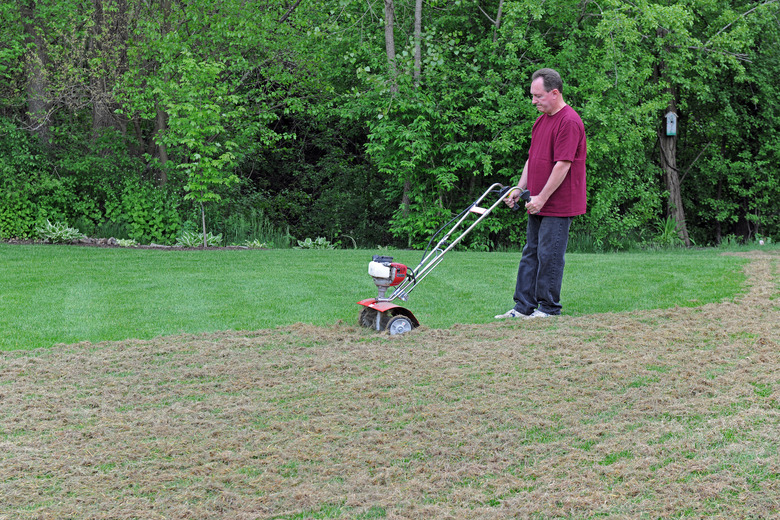How To Kill Grass Mites
We may receive a commission on purchases made from links.
Grass mites encompass several species of tiny mites that suck the sap out of turfgrass. Some of these mites also infest houseplants, flower gardens, and vegetable gardens. To successfully eradicate these tiny pests, use a combination of cultural controls, insecticidal soaps, and miticides, which are pesticides specifically formulated to kill grass mites and other spider mite species.
Types of Grass Mites
Types of Grass Mites
The Banks grass mite (Oligonychus pratensis), Bermudagrass mite (Eriophyes cynodoniensis), brown wheat mite (Petrobia latens), clover mite (Bryobia praetiosa), twospotted spider mite (Tetranychus urticae Koch), winter grain mite (Penthaleus major), zoysiagrass mites (Eriophyes zoysiae) and other members of the family Tetranychidae are not insects; they are more closely related to spiders. While the clover mite and twospotted spider mite feed on many different plants, the Bermudagrass mite is specific to the warm-season grass that carries its name.
In general, a grass mite life cycle begins with the egg and then the larva, nymph, and mature adult stages. The time from egg to adult ranges between five and 20 days depending on the species and temperature. Hotter days mean faster development into adult mites. A female grass mite can lay several hundred eggs during her two to four weeks as an adult.
While multiple generations of grass mites thrive through the summer, when the weather begins to cool, the adult females move to sheltered areas where they continue to lay eggs until the weather turns cold, and they go into hibernation. In spring, the eggs hatch, and females emerge to feed on the new growth of your lawn. Clover and winter grain mites are exceptions. As cool-season pests, they thrive from fall through spring and then go dormant when temperatures rise above 75 degrees Fahrenheit.
Signs of Grass Mites
Signs of Grass Mites
Signs of grass mites include stunted growth, yellowish-brown patches in the lawn, silvery streaks on the grass blades, and eventually, large swaths of dead grass. Bermudagrass may develop tufts or rosettes with short stems and crowded leaf blades, commonly called "witchesbrooming." Zoysiagrass blades roll inward and when unrolled reveal pale yellow or white streaks.
Because grass mites are extremely small, a 10X to 30X magnifying glass is necessary to clearly identify these sap-sucking pests. Under the glass, their round or elongated bodies and eight legs are clearly visible. The mites can range from yellowish-green to light brown to reddish-brown, sometimes with spots depending on the species. Some but not all grass mites produce webbing between the grass blades.
Cultural Controls for Grass Mites
Cultural Controls for Grass Mites
To reduce the population of grass mites, begin with regular watering but avoid overfertilizing. Drought-stressed lawns are vulnerable to the pests. Remove any grassy weeds in the area and mow at the recommended height for the grass species. Don't leave the clippings on the grass; bag and dispose of them in the trash to remove eggs, larvae, nymphs, and mature mites.
Dethatch Bermudagrass in spring when new growth appears to remove the mites. Begin dethatching the lawn in uninfected areas and then progress to the infected areas and remove as much of the debris as possible. A dethatcher with a grass catcher is more efficient than dethatching and raking. Water thoroughly after dethatching. In fall, remove plant debris, dead weeds, and other hiding places for the female mites and eggs.
Consider releasing predatory mites in early spring and fall. Commercially available combinations of predatory mites may include Amblyseius andersoni, Amblyseius swirskii, Neoseiulus californicus, Phytoseiulus persimilis, and other species. Scatter the mites over the infested areas immediately after delivery. Avoid applying pesticides after releasing the predatory mites; they are susceptible to the same insecticides and miticides as the grass mites.
Other Methods of Eradicating Mites
Other Methods of Eradicating Mites
In addition to cultural methods, you can knock mites off plants with a high-pressure water spray. If the lawn and surrounding landscape is suffering from severe infestations, consider applying horticultural oils or insecticidal soaps that kill mites on contact. Pyrethroid products and pesticides formulated for use on mites and other pests can also be applied to the lawn. Follow the directions on the label to avoid exposure to the chemicals in the pesticides.
